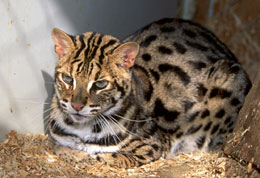| Asian Leopard Cat | ||

| There
are 37 species of wild cats in the world, 30 of
which are considered small wild cats. The more
well-known species including the bobcat, lynx,
margay, ocelot, and the wild cat. There are also
numerous species not so well know including the
sand cat, fishing cat, pampas cat, Geoffrey's
cat, Pallas' cat. Of the small cats the leopard
cat is probably one of the most common and
widespread, occurring throughout much of southern
and eastern Asia, including the Philippines and
Indonesia. Most authorities do not consider the
leopard cat in imminent danger of extinction but
the destruction of habitat by rapidly expanding
human population, forest clear cutting, slash and
burn, farming and soil erosion, remains a constant threat to wild cats as they are forced into smaller and smaller areas in which to live. In the US, there are approximately 27 leopard cats in zoos and an unknown number owned by private citizen. The scientific literature describes leopard cats as "house cat size with somewhat longer legs" although size varies depending on the subspecies. Those in the Philippines weigh only 5 lbs. Although they do not appear to be heavier in the wild than weights commonly attained in house cats, some leopard cats are much longer than house cats if measured from head to tail. The background color of the coat is highly variable depending on where the cat if from, and ranges from bright reddish to gray, golden, or tawny brown. The under parts are spotted on a white background, and the tail is ringed toward the tip. There are usually four longitudinal bands running from the forehead or inner eye corners to behind the neck that break into short bands and elongated spots over the shoulders, although sometimes one stripe runs the length of the body. The spots are rosetted in some of the cats, solid in others. The head is relatively small with a narrow muzzle and the ears are described in the literature as moderately long and narrow with rounded tips. There is a white spot on the back of the ear typical of spotted cat species. The eyes are large and amber to gray in color. Two narrow black cheek stripes run from the corners of the eye, enclosing a white are on the cheek. The leopard cat is extremely variable in the types of areas in which it can live. They are found in a variety of forested habitats at both high and low elevations, as well as scrub, semi desert, and agricultural areas. Very few scientific studies have been conducted on the relatively common Asian cat, but it is believed to be highly arboreal in its jungle home. { I have seen many a bengal leaping to the highest point in the house to peer down at the world below.} Their hunting habits include catching rodents, birds, reptiles, fish and insects. Probably one of the most misunderstood aspects of the leopard cat's behavior is it's reputation for ferocity and it's inability to be domesticated. The Asian leopard cat has evolved as an efficient little predator that occupies a special niche wherein it lives and reproduces in what is often a hostile world. Just because it doesn't settle easily into our tame and domesticated world should not be a criteria with which we judge an animal "mean". In Asia, some villagers are reported as keeping leopard cats around to hunt mice. There have been many reports of the leopard cats being very friendly and following their owners around the house. How ever there has also been stories of leopard cats, bottle raised from birth, that revert to their wild and shy temperaments upon maturity, to realize that they are not an easily domesticated animal. Perhaps that is as it should be. Most people have neither the temperament nor the facilities to keep wild cats and most of these cats are better off in their wild homes. I believe that the Bengal is the perfect answer to satisfy the need in many of us to live with exotic spotted cats. Although understanding the leopard cat and it's behavior, may go a long way to helping us understand our Bengals, maybe the reverse is also true. Perhaps in living with and understanding our Bengals, we will come to appreciate and care about the future of the leopard cat and it's kind, who are relying on our good will for their very survival in the lands they inhabit.
|
||